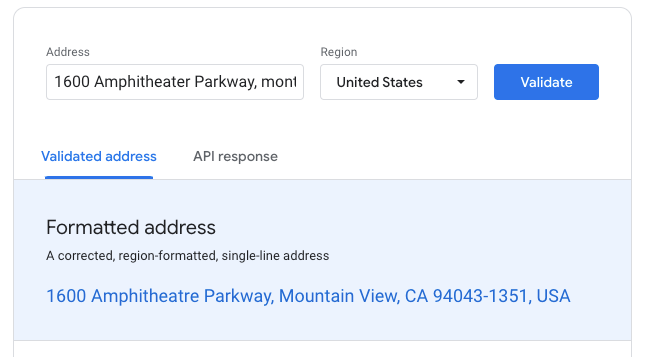Einführung
Die Address Validation API ist ein Dienst, der eine Adresse akzeptiert. Es identifiziert Adresskomponenten und validiert sie. Außerdem wird die Adresse für den Postversand standardisiert und die genauesten Breiten- und Längengradkoordinaten für sie ermittelt. Optional können Sie für Adressen in den USA und Puerto Rico das Coding Accuracy Support System (CASS™) aktivieren.Gründe für die Verwendung der Address Validation API
Mit der Address Validation API können Sie die Vorhersagbarkeit von Lieferungen verbessern und Lieferfehler reduzieren, um die Kundenzufriedenheit zu steigern. Dazu müssen Sie ungültige Adressen erkennen und sich ein besseres Bild von den Adressmerkmalen machen.
Die Geocoding API ist möglicherweise besser für Ihre Anforderungen geeignet, wenn Sie die einzelnen Adresskomponenten nicht validieren müssen. Mit der Geocoding API werden Adressen in Breiten- und Längengradkoordinaten umgewandelt. Mit der Address Validation API werden Adressen auf Richtigkeit geprüft. Einen detaillierten Vergleich finden Sie im Architecture Center unter Building location validation capability using Google Maps Platform.
Funktionen der Address Validation API
Mit der Address Validation API können Sie ermitteln, ob eine Adresse einen realen Ort bezeichnet. Wenn die Adresse sich nicht auf einen realen Ort bezieht, kann die API möglicherweise falsche Komponenten identifizieren, die Sie Ihren Kunden zur Korrektur präsentieren können. Hier ist ein Beispielworkflow mit der API:
Kunde gibt eine Adresse ein: Das folgende Bild zeigt ein einfaches Formular, in dem ein Kunde eine Adresse eingeben kann, möglicherweise im Rahmen eines Bezahlvorgangs.
App sendet die Adresse an die API: Die Anwendung übergibt diese Adresse als Eingabe an die Address Validation API.
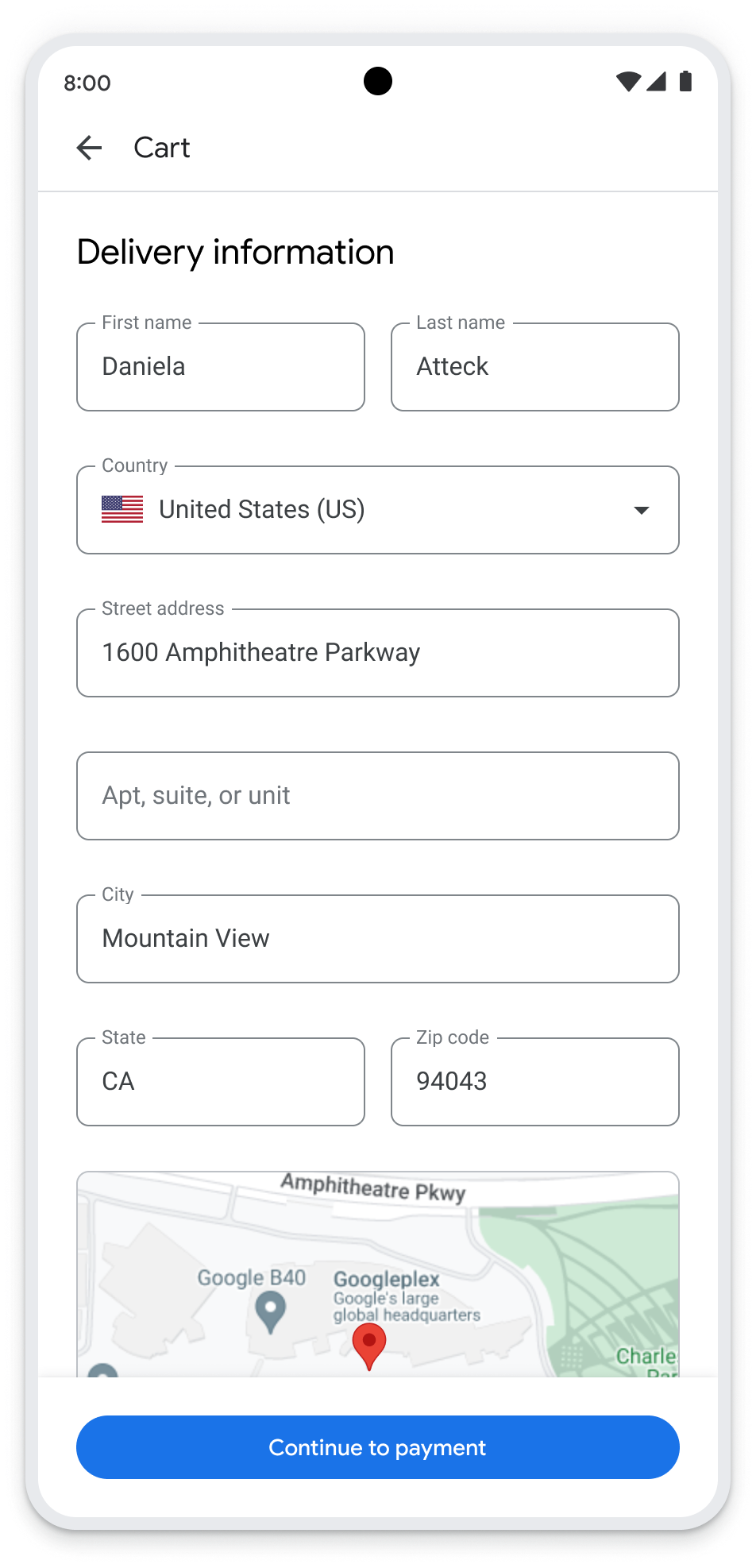
API validiert und standardisiert die Adresse: In der Antwort gibt die Address Validation API die vollständige Adresse zurück, die von der API ermittelt wurde, oder gibt an, wo Informationen fehlen.
Kunde bestätigt oder korrigiert die Adresse: Je nachdem, was die API zurückgibt, können Sie dem Kunden die folgenden Aufforderungen anzeigen: A. Bestätigen Sie die empfohlene Adresse. B. Geben Sie fehlende Informationen an. C. Korrigieren Sie die Adresse.
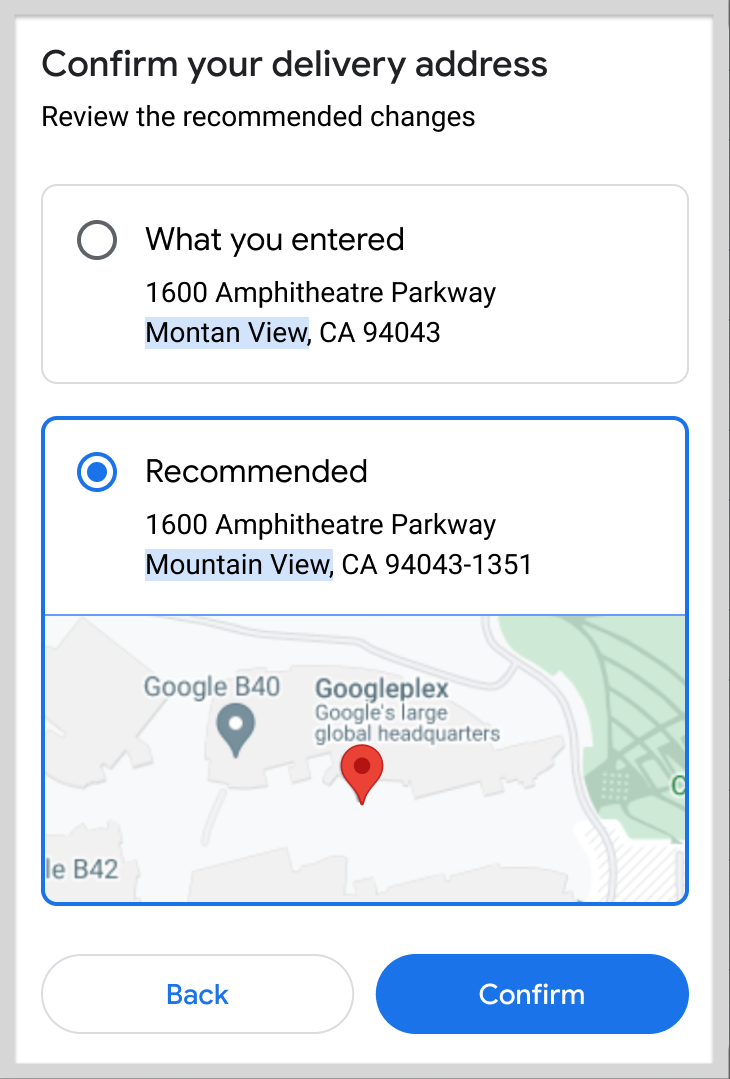
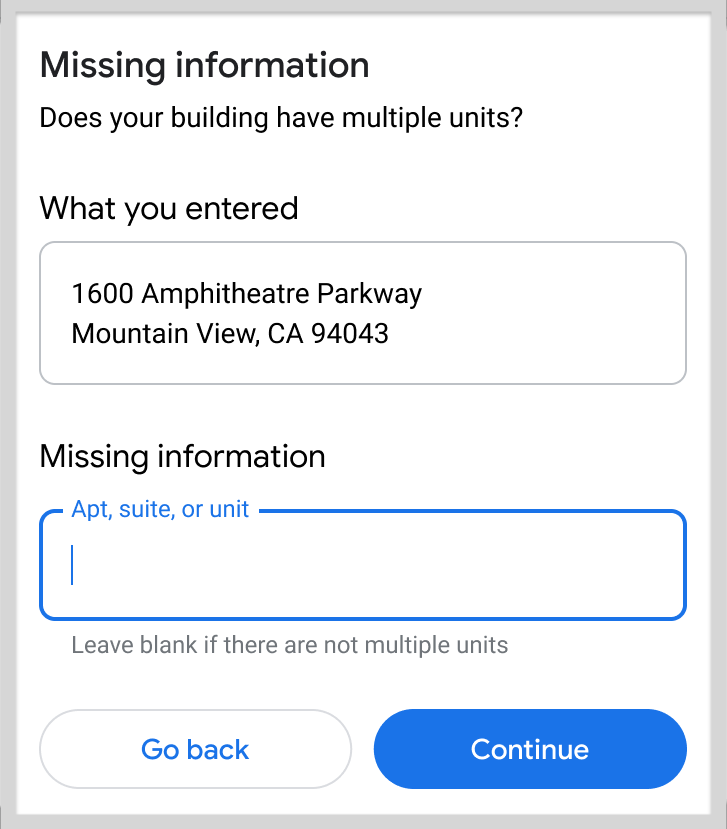
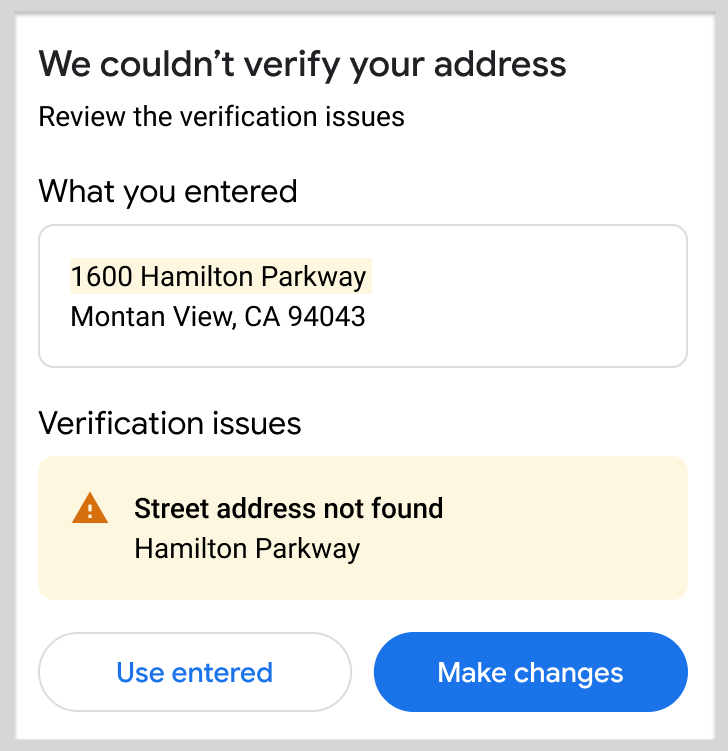
Funktionsweise der Address Validation API
Die Adressvalidierung akzeptiert eine POST-Anfrage mit der Adresse in Form eines JSON-Texts. Die Adresse wird in ihre einzelnen Komponenten unterteilt und dann wird Folgendes versucht:
- Korrekturen: Bietet Validierungsprüfungen auf Komponentenebene, einschließlich untergeordneter Räumlichkeiten, sofern verfügbar.
- Vervollständigen: Versucht, fehlende oder falsche Adresskomponenten abzuleiten.
- Formate: Bereinigt und standardisiert das Format für Adresskomponenten.
Ressourcen
In der folgenden Tabelle sind die über die Address Validation API verfügbaren Ressourcen sowie die zurückgegebenen Daten zusammengefasst. Weitere Informationen finden Sie in der Referenz zur Address Validation API.
| Datenressourcen | Zurückgegebene Daten |
|---|---|
|
Adresskomponenten im JSON-Format Weitere Informationen finden Sie unter Adresse bestätigen. |
Vollständige, bestätigte Adresse (falls möglich) Validierungsstatus der einzelnen Adresskomponenten. So sehen Sie, ob die Funktion für eine Adresse verfügbar ist:
Weitere Informationen finden Sie unter Validierungsantworten verstehen. |
Address Validation API verwenden
| 1 | Demo ausprobieren | Demo ansehen mit verschiedenen Adressformularen, sowohl korrekten als auch falschen. Die Demo bietet eine nützliche Möglichkeit, sowohl die Rückgabewerte des Dienstes als auch die JSON-formatierte API-Antwort zu untersuchen. |
| 2 | Abdeckung prüfen | In den Details zur Abdeckung können Sie nachlesen, welche Länder und Regionen von der Address Validation API unterstützt werden. |
| 3 | Einrichten | Beginnen Sie mit Google Cloud-Projekt einrichten und folgen Sie der Anleitung. |
| 4 | Adressbestätigung anfordern | Beginnen Sie mit einer einfachen Adresse. Für zusätzliche Genauigkeit können Sie dann CASS aktivieren (nur für Adressen in den USA und Puerto Rico). Weitere Informationen finden Sie unter Adressbestätigung anfordern. |
| 5 | Antwort verarbeiten | Die Antwort der Address Validation API enthält zwei Eigenschaften, die Sie jeweils auf unterschiedliche Weise verwenden. Weitere Informationen |
| 6 | Genauigkeit der Validierung verbessern | Sie können die Genauigkeit von Adressen verbessern, indem Sie Feedback zu Antworten der Address Validation API geben. Weitere Informationen finden Sie unter Aktualisierte Adressen verarbeiten. |
Verfügbare Clientbibliotheken
Eine Liste der verfügbaren Clientbibliotheken für die Address Validation API finden Sie unter Clientbibliotheken.
CASS™
Der United States Postal Service® (USPS®)1 unterstützt und zertifiziert Adressvalidierungsanbieter mit dem Programm Coding Accuracy Support System (CASS™). Ein CASS Certified™-Dienst wie die Address Validation API wurde auf seine Fähigkeit hin überprüft, fehlende Informationen in einer Adresse zu ergänzen, sie zu standardisieren und zu aktualisieren, damit Sie die aktuellste und genaueste Adresse erhalten.
CASS ist nicht standardmäßig aktiviert und wird nur für die Regionen „US“ und „PR“ unterstützt. Wenn Sie CASS aktivieren möchten, legen Sie enableUspsCass im Rahmen einer Validierungsanfrage auf true fest. Weitere Informationen finden Sie unter Adresse bestätigen.
Im Rahmen der Nutzung von USPS-Diensten prüft USPS Anfragen für künstlich erstellte Adressen. Wenn USPS eine eingegebene Adresse als künstlich erstellt identifiziert, muss Google die Validierung von Adressen für den Kunden einstellen und die Kontaktdaten des Kunden (Name und Adresse), die entsprechende eingegebene Adresse und aggregierte Nutzungsdaten an USPS melden. Durch die Verwendung der API stimmen Sie diesen dienstspezifischen Nutzungsbedingungen zu.
Nächste Schritte
- Demo ausprobieren: Rufen Sie die Demo auf.
- Abdeckungsbereiche ansehen: Rufen Sie die Details zur Abdeckung nach Land und Region auf.
- Erste Überprüfungsanfrage senden: Anfrage zur Adressüberprüfung senden
- Adressen in großen Mengen verarbeiten: Weitere Informationen finden Sie unter Address Validation API zum Verarbeiten von Adressen in großen Mengen verwenden.
-
Die Google Maps Platform ist ein nicht exklusiver Lizenznehmer von United States Postal Service®. Die folgenden Marken sind eingetragene Marken von United States Postal Service® und werden mit dessen Zustimmung verwendet: United States Postal Service®, CASS™, CASS Certified™. ↩


